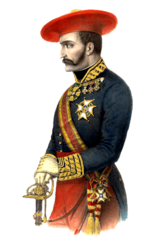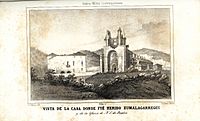Tomás de Zumalacárregui facts for kids
Quick facts for kids
Tomás de Zumalacárregui
|
|
|---|---|
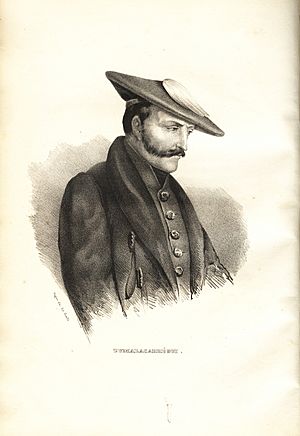
Lithography of Zumalacárregui, 1837
|
|
| Captain general of the Carlist Army | |
| In office 23 June 1835 – 24 June 1835 |
|
| Monarch | Infante Carlos |
| Personal details | |
| Born |
Tomás de Zumalacárregui e Imaz
29 December 1788 Ormaiztegi, Gipuzkoa, Spain |
| Died | 24 June 1835 (aged 46) |
| Parents |
|
| Occupation | Military commander |
Tomás de Zumalacárregui e Imaz (in Basque: Tomas Zumalakarregi Imatz; born December 29, 1788 – died June 24, 1835) was a famous Spanish Basque military leader. His soldiers called him "Uncle Tomás." He led the Carlist army during the First Carlist War. He was sometimes known as the "Wolf of the Amezcoas." This nickname came from a big military win in the Navarre region.
Many people say Zumalacárregui invented the Spanish omelette (or tortilla de patatas). He supposedly made it during the Siege of Bilbao. He wanted a simple, quick, and healthy meal for his soldiers. He found a housewife who only had eggs, onions, and potatoes. He mixed them, liked the taste, and fed it to his hungry troops. It is said that the tortilla became very popular during the First Carlist War. Today, it is one of the most famous dishes in the world.
Contents
Tomás de Zumalacárregui: A Military Leader
Early Life and First Wars
Tomás de Zumalacárregui was born in Ormaiztegi, a Basque area in Spain. This was on December 29, 1788. His father was a lawyer with some land. Tomás first trained to be a lawyer too.
In 1808, the Peninsular War started when France invaded Spain. Tomás joined the army in Zaragoza. He fought in the first Siege of Zaragoza that year. He also fought in the Battle of Tudela. He was part of the second Siege of Zaragoza in 1809. He was captured but managed to escape. He then returned to his family in Navarre.
For a short time, he joined a guerrilla group. This group was led by Gaspar de Jáuregui, known as "The Shepherd." But Tomás was a serious and quiet person. He did not like the messy life of guerrillas. So, he joined the regular army as an officer. He served in the regular army for the rest of the war.
His brother, Miguel Antonio, was in Cádiz. He helped create the Spanish Constitution of 1812. Tomás was sent to Cádiz and became a captain. He fought as a captain in the Battle of San Marcial in 1813. After King Ferdinand VII returned to power, Tomás stayed in the army. He studied military strategies very carefully.
A Strong Royalist Officer
Zumalacárregui did not agree with the new liberal ideas spreading in Spain. He was known as a strong Royalist. This meant he supported the king's absolute power. Other officers who supported liberal ideas tried to get him removed. He was suspected of trying to get soldiers to support the king. So, he escaped to France.
In 1823, he came back to Spain. He joined a royalist army that had formed in France. He was now seen as a very loyal servant to the king. He helped bring order to regiments the government did not trust. He became a lieutenant-colonel in 1825 and a colonel in 1829. In 1832, he became the military governor of Ferrol, Galicia.
Before King Ferdinand VII died in 1833, Zumalacárregui was known as a supporter of the traditional party. This party wanted the king's brother, Infante Carlos, Count of Molina, to be the next king.
Leading the Carlist War
When King Ferdinand VII died, his daughter Isabel was named queen. This led to a conflict. Zumalacárregui was put on half pay. He was told to live in Pamplona under police watch.
The Carlist uprising began after Ferdinand VII's death. Zumalacárregui waited to join. He joined when the Carlist cause seemed to be losing. He became the Commander-in-Chief in Navarre for Don Carlos.
He escaped Pamplona on October 29, 1833. The next day, he took command. At first, the Carlist army was small and weak. It had only a few hundred poorly armed fighters. But in a few months, Zumalacárregui turned them into a strong, regular army. It was hard to get supplies. Many coastal towns, like Bilbao, supported the other side. He mostly armed his forces by taking equipment from government troops.
He slowly gained control of the Southern Basque Country. He could not attack the big fortresses because he lacked the tools. He created special forces like the aduaneros and the Guías de Navarra. His main bodyguard and later writer was Charles Frederick Henningsen.
Zumalacárregui was a great leader in the mountains. He was unbeatable whether leading guerrillas or a regular army. He won battles like Alsasua, Alegría de Álava, and Venta de Echavarri. He used smart guerrilla tactics in these fights.
By July 1834, it was safe for Don Carlos to join his headquarters. Zumalacárregui was very successful. But other officers and people around Don Carlos became jealous of him. Don Carlos was also easily influenced by others. So, Zumalacárregui had to deal with a lot of distrust and plots.
By early June 1835, he had made the Carlist cause strong north of the Ebro river. He had an army of over 30,000 men. This army was much better than the government forces. He won the battle of Artaza in April 1835.
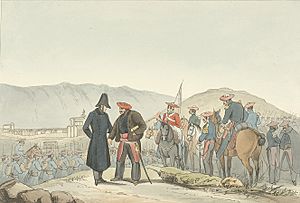
Zumalacárregui wanted to gather his forces and march on Madrid. He believed this would help Don Carlos take the capital. But the court wanted to control a seaport. They thought this would help other European countries recognize Don Carlos as the rightful king. So, Zumalacárregui was ordered to attack Bilbao. He did so, even though he did not want to.
On June 14, 1835, he was shot in the leg by a musket. This happened near the Basilica of Begoña. The wound was small and should have healed easily. But Zumalacárregui chose a local healer named "Petriquillo." Petriquillo tried to remove the bullet. This caused a lot of blood loss and likely an infection. Don Carlos sent his own doctors, but they were too slow. Petriquillo acted when they were not there. Zumalacárregui died on June 24, 1835. Petriquillo quickly left the scene. Some people even suspected poison.
Zumalacárregui was a true example of the old royalist and religious beliefs of his people. The government forces often refused to spare Carlist soldiers. They did not see them as real fighters. This made the war very brutal. Zumalacárregui felt he had to get revenge against the liberal forces. However, before he died, he signed the Lord Eliot Convention. This agreement aimed to stop the killing of prisoners on both sides.
His Lasting Popularity
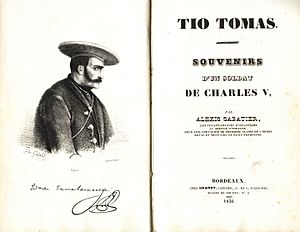
One of the best stories about Zumalacárregui's Carlist campaign is in Juan Antonio de Zaratiegui's book. Zaratiegui was Zumalacárregui's assistant, secretary, and friend. He was also an important Carlist military officer.
Another book, The Most Striking Events of a Twelvemonth Campaign with Zumalacarregui in Navarre and the Basque Provinces, was written by Charles Frederick Henningsen. Henningsen wrote that Zumalacárregui was an amazing man. He said Zumalacárregui's name would be remembered in Spain for a very long time. He believed Zumalacárregui played a huge part in the early successes of the Royalist army.
In 2017, the People's Party of the Basque Country suggested renaming a street named after him.
Zumalacárregui in Literature
Zumalacárregui is the main character in a book called Episodio nacional by Benito Pérez Galdós. In the book, he is shown as a very smart man and a great planner. He fights for what he believes is right.
See also
 In Spanish: Tomás de Zumalacárregui para niños
In Spanish: Tomás de Zumalacárregui para niños


